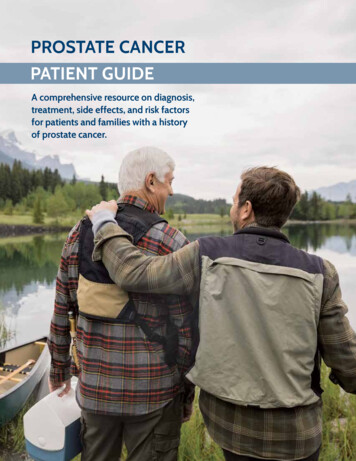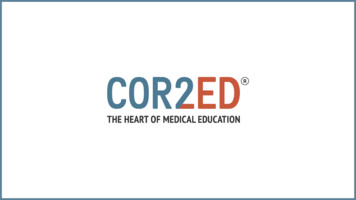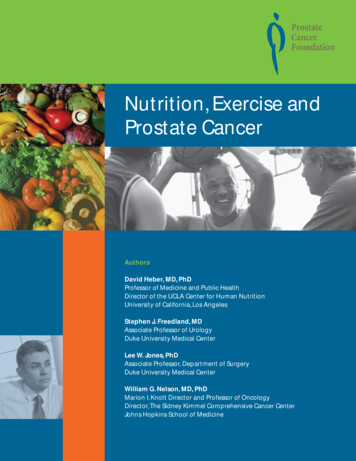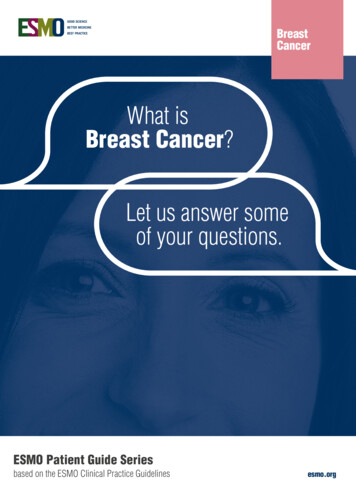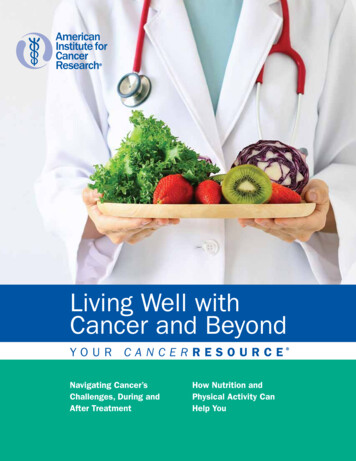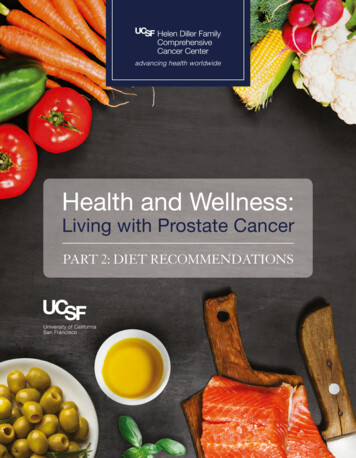
Transcription
Part II: Diet RecommendationsHealth and Wellness:Living with Prostate CancerPart 2: Diet recoMMenDations1
Part II: Diet Recommendations3table of contentsShared Authorship. . . . . . . . . . . . . . . . . . . . . . . . . . . . . . . . . . . . . . . . . . . . 4Nutrition & Prostate Cancer. . . . . . . . . . . . . . . . . . . . . . . . . . . . . . . . 5Guidelines for a Healthy Diet & Lifestyle . . . . . . . . . . . . . . . . . . . . . . . . . . . . . . . . . . . . . . . . 5Plant-Based Diet . . . . . . . . . . . . . . . . . . . . . . . . . . . . . . . . . . . . . . . . . . . . . . . . . . . . . . . . . . . . . 6Fruits and Vegetables . . . . . . . . . . . . . . . . . . . . . . . . . . . . . . . . . . . . . . . . . . . . . . . . . . . . . . . . . 7Plant Foods & Prostate Cancer: Obtain nutrients from foods,not supplements. . . . . . . . . . . . . . . . . . . . . . . . . . . . . . . . . . . . . . . . . . . . . . . . . . . . . . . . . . . . . . 8Organic Produce . . . . . . . . . . . . . . . . . . . . . . . . . . . . . . . . . . . . . . . . . . . . . . . . . . . . . . . . . . . . 10SUGARS AND THE ROLE OF INSULIN. . . . . . . . . . . . . . . . . . . . . . . . . . . . 11Fat – The Bottom Line. . . . . . . . . . . . . . . . . . . . . . . . . . . . . . . . . . . . . . . . . . . . . . . . . . . . . . . 11Sweeteners . . . . . . . . . . . . . . . . . . . . . . . . . . . . . . . . . . . . . . . . . . . . . . . . . . . . . . . . . . . . . . . . . 12DIETARY FATS. . . . . . . . . . . . . . . . . . . . . . . . . . . . . . . . . . . . . . . . . . . . . . . . . . . . 13Fat – Bottom Line. . . . . . . . . . . . . . . . . . . . . . . . . . . . . . . . . . . . . . . . . . . . . . . . . . . . . . . . . . . 14Animal Fat. . . . . . . . . . . . . . . . . . . . . . . . . . . . . . . . . . . . . . . . . . . . . . . . . . . . . . . . . . . . . . . . . 15Beverages . . . . . . . . . . . . . . . . . . . . . . . . . . . . . . . . . . . . . . . . . . . . . . . . . . . . . . 18Nutrients . . . . . . . . . . . . . . . . . . . . . . . . . . . . . . . . . . . . . . . . . . . . . . . . . . . . . . 19HORMONE DEPRIVATION THERAPY AND NUTRITION. . . . . . . . . 22Bone-Building Nutrition . . . . . . . . . . . . . . . . . . . . . . . . . . . . . . . . . . . . . . . . . . . . . . . . . . . . . 22SUMMARY - HEALTHY PROSTATE CANCER DIET. . . . . . . . . . . . . . . . 23Frequently Asked Questions. . . . . . . . . . . . . . . . . . . . . . . . . . . . . . . . . . . . . . . . . . . . . . . . . . 24Glossary. . . . . . . . . . . . . . . . . . . . . . . . . . . . . . . . . . . . . . . . . . . . . . . . . . . . . . . . . . . . . . . . . . . . 25Three Day Menu Plan: 3 Meals Snack. . . . . . . . . . . . . . . . . . . . . . . . . . . . . . . . . . . . . . . . 26References. . . . . . . . . . . . . . . . . . . . . . . . . . . . . . . . . . . . . . . . . . . . . . . . . . . . . 28
4Health and Wellness: Living with Prostate CancerShared AuthorshipNatalie Lagomarcino Ledesma, MS, RD, CSO†Oncology DietitianHelen Diller Family Comprehensive Cancer CenterUniversity of California, San FranciscoErin L. Van Blarigan, ScDAssistant Professor, Departments of Epidemiology & Biostatistics and UrologyUniversity of California, San FranciscoGreta Macaire, MA, RD, CSOOncology DietitianHelen Diller Family Comprehensive Cancer CenterUniversity of California, San FranciscoJune M. Chan, ScDSteve & Christine Burd-Safeway Distinguished Professor, UrologyProfessor, Departments of Epidemiology & Biostatistics and UrologyUniversity of California, San FranciscoStacey A. Kenfield, ScD†Helen Diller Family Chair in Population Science for Urologic CancerAssociate Professor, Department of UrologyUniversity of California, San FranciscoPatient AdvocatesStan Rosenfeld, George Tacticos, David SchwartzThis guide was developed as a companion to complement the Prostate CancerFoundation’s “Health and Wellness: Living with Prostate Cancer” document.For a broader introduction and our overarching lifestyle recommendations,please see this document at PCF: https://www.pcf.org/guide/ or at UCSF:https://urology.ucsf.edu/lifestyle-studies† NLL is lead author and SAK is senior author.* All words with an asterisk (*) are defined in the glossary on page 25.
Part II: Diet Recommendations5nutrition & Prostate cancerA healthy diet may reduce the risk of developing prostate cancer and possibly prevent or delay prostatecancer progression. Good nutrition also reduces the risk of developing other major chronic diseases, such asdiabetes, obesity, hypertension and heart disease. It is estimated that one-third of cancer deaths in the UnitedStates can be attributed to adult diet and physical activity, including their role in obesity.1 Scientific evidencesuggests that differences in diet and other lifestyle behaviors, such as exercise and smoking, may account formuch of the variability in the rates of major chronic diseases across countries, including many cancers.2Guidelines for a Healthy Diet & Lifestyle Plant-based diet.o Rich in fruits and vegetables.o High fiber – beans/legumes, nuts, seeds, whole grains. Include lean protein with every meal – aim to include plant protein daily.o Plant proteins: beans/legumes, soy products (e.g., edamame, tofu, tempeh).o Lean animal proteins: fish, skinless poultry. Choose healthy fats when cooking/baking, on salads, or at the table,such as extra-virgin olive oil, nut oils (e.g., macadamia nut oil, almond oil),avocados, and nuts/seeds. Choose whole grains such as quinoa, wild rice, brown rice, oatmeal,amaranth, and teff, over processed and refined grains. Limit added sugars. Drink a sufficient amount of water ( 8 cups/day). Do not drink sugar-sweetened beverages. If you choose to drink alcohol, limit to 2 drinks per day or fewer for men(one drink or fewer per day for women). Be physically active. Build up to 150 minutes/week or more of aerobicexercise and 2-3 sessions/week of resistance exercise, balance training,and flexibility exercises. Achieve and/or maintain a healthy weight.
6Health and Wellness: Living with Prostate CancerFood CategorySummaryRecommendationFruits andvegetablesOne serving ½ cup fruit or vegetable,1 cup raw leafy greens,¼ cup dried fruit or vegetable,6 oz. vegetable juice.At least 5, preferably 8-10,total servings dailyEat 1 serving or more vegetableswith every meal and snack.5 or more vegetable servings/day2-3 fruit servings/dayChoose breads with 3or more grams of fiber per slice.First ingredient on the label shouldbe whole or sprouted grain flour,not white flour, unbleached white flour,or enriched wheat flour.FiberNote that white whole wheat flouris a whole grain – the “white” refersto the type of wheat.Examples of whole grains include oats,barley, brown rice, quinoa,amaranth, bulgur, millet, wild rice,buckwheat, spelt, and teff.Refinedcarbohydratesand added sugarsDietary sources include productsmade with refined flours (for example:white bread, white rice, white pasta)or refined grains, alcohol, sodas,drinks containing added sugars,and desserts, such as candy, cookies,cakes, and pastries.30-45 grams dailyThis goal can be achieved bymeeting your fruit and vegetablegoal plus one serving of chia/flaxseeds (1 Tbsp), one servingof legumes (1/2 cup cooked),or at least two servings ofwhole grains (1 cup cooked).Limit or avoid consumption.Plant-Based DietA plant-based diet consists primarily of fruits, vegetables, beans/legumes, nuts/seeds, whole grains, and otherplant protein sources. Meat, dairy, eggs, fish, and other seafood can still be consumed, but should makeup a small proportion of the total food. For example, an ideal plate is filled with ½ or more vegetables andfruits, ¼ lean protein sources, and up to ¼ starchy vegetable (e.g., sweet potatoes, winter squash, corn) orwhole grains. Healthy fats are also an important component; at least one serving should be included each day(1 ounce of nuts, 1 Tbsp of olive oil, ⅓ medium avocado).A plant-based diet is associated with improved cardiovascular health, lower risk of diabetes, healthier bodyweight, and lower risk of death. Moreover, emerging science indicates that a lifelong commitment to a plantbased diet may lower a man’s risk of developing prostate cancer and, after prostate cancer diagnosis, reducethe risk of cancer recurrence or progression. Preliminary evidence suggests that dietary and lifestyle changesare associated with a decrease in PSA and prostate cancer cell growth in men on active surveillance for low riskprostate cancer.3 One study assessing the risk of recurrence of prostate cancer found that a plant-based diet,in combination with stress reduction and moderate physical activity, may slow prostate cancer progression, butthese results are not definitive.4 PSA doubling time, a measure of risk of prostate cancer recurrence, increasedfrom 11.9 months (pre-study) to 112.3 months (after the study), indicating slower progression. Additionally,individuals who made comprehensive lifestyle changes improved their quality of life.5Read below for more information about specific components of a plant-based diet.
7Part II: Diet RecommendationsFruits and Vegetables Healthy diets should include plenty of vegetables and fruit; aim for 5 or more vegetables and 2-3 fruits daily. Fruits and vegetables contain vitamins, minerals, fiber, and phytonutrients* (for example: carotenoids,lycopene, indoles, isoflavones, and flavonols). Vibrant, intense COLOR is one indicator of phytonutrient* content. Consumption of fruit juice should be minimal, if consumed at all. Smoothies comprised of whole vegetablesand fruits are fine to include in the diet. The fiber in juice has been removed, and fruit juices are high in quickly-digested carbohydrates. Thesecarbohydrates cause a spike in blood sugar without creating a sense of fullness, and can lead to overeating. The fiber in whole fruits and vegetables slows the digestion of natural sugars and fills you up,making it hard to eat too many calories from these foods.Healthy PlateDiagramFill your plate withapproximately 50%(or more) vegetables,25% (or more) lean protein,and up to 25% starchyvegetable or whole grain.Include at least one servingof healthy fats(1 ounce of nuts,1-2 Tbsp olive oil,1/3 medium avocado)each day.
8Health and Wellness: Living with Prostate CancerPlant Foods & Prostate Cancer:Food & FoodCompoundAlliumvegetablesFunctionRich in flavonoidsand organosulfurcompounds thathave anti-cancerpropertiesDietary SourcesOnions, garlic,leeks, chives,scallions, shallotsRecommendationPopulations who consume highamounts of allium vegetables havebeen reported to have a lower rateof overall cancer.6-9More research is necessary fora formal recommendation regardingtheir effects on the risk of prostatecancer, but evidence suggestsregular consumption of thesevegetables benefits overall health.Betacarotenerich fruits &vegetablesConvertedto vitamin A;antioxidant* activityhelps protect cellsfrom damageCarrots, cantaloupe,sweet potatoes,winter squash,mangoThe protective effects of fruitsand vegetables against cancermay be related to high levels ofcarotenoids.7, 10-15 Higher plasmacarotenoids may contributeto a reduced risk of prostatecancer, but no association wasobserved between carotenoidsand disease progression.16 Moreresearch is necessary for a formalrecommendation regarding prostatecancer, but evidence suggests thatconsuming these vegetables dailyis good for overall health. Do nottake a beta-carotene supplement.CruciferousvegetablesRich in vitamins,minerals, andantioxidants*;glucosinolates,such as indole3-carbinol anddiindolylmethane(DIM) offer anticancer activity17,18Arugula, broccoli,Brussels sprouts,cabbage, cauliflower,collard greens, kale,horseradish, kohlrabi,mustard greens,radishes, rutabaga,turnips, turnipgreens, watercressInclude these vegetables in yourdiet daily.
9Part II: Diet RecommendationsObtain nutrients from foods, not supplementsFlaxseedand lignansGood source ofomega-3 fatty acidsand fiber; containsprotein, calcium,potassium,B vitamins, iron,and boron.FlaxseedMay block tumorgrowth, enhanceimmune function,and inhibitangiogenesis*19,20Lycopenerichfruits andvegetablesSoy andIsoflavones(i.e., genistein,daidzein)Lycopene isan antioxidant*that scavengesfree radicals toreduce tissuedamage; inhibitscell proliferationand increasesapoptosis*21-25Rich nutrientprofile – goodsource of protein,fiber, calcium,and B vitaminsAntioxidant*rich; may preventprostate cancerprogression26Consider eating 2 Tbsp groundflaxseed daily. Flax can havea laxative effect so increaseconsumption gradually. Sprinkleinto various foods and beverages,including hot cereals, tomato sauces,smoothies, or grains. Opt for groundflax seeds to increase bioavailabilityrather than whole flax seeds, flaxseed oil, or flax supplements. Flaxseeds may be ground in a coffeegrinder, blender, or food processor.Store ground flax in the refrigeratoror freezer.Tomatoes (raw andcooked, such astomato paste, sauce,juice, etc.), guava,watermelonSoybeans, edamame,tofu, tempeh, miso,natto, soy milk,and soy nutsInclude dietary lycopene fromfoods daily; do not take a lycopenesupplement. Cooked tomatoproducts or juices contain higheramounts of lycopene.Lycopene is best absorbed whenconsumed with fat, such as oliveoil, avocado, or nuts. For example,marinara sauce cooked with olive oilis a good source of lycopene.Research suggests that soymay lower the risk of prostatecancer and inhibit prostate cancerprogression, but more conclusiveevidence is needed.Include soy regularly in the diet.Soy foods, such as those listed,are preferred over processed soyproducts using soy protein isolateor soy isoflavone extracts.Soy supplements or isoflavoneextracts are not recommended.
10Health and Wellness: Living with Prostate CancerOrganic ProduceOrganic fruits and vegetables have fewer pesticides, lower levels of total pesticides, and less overall pesticidetoxicity than fruits and vegetables grown with chemicals. Although more research is needed, recent evidenceindicates a significant increase in antioxidants* in organic and sustainably-grown foods versus conventionallygrown foods.27-30Listed below are produce with the most and least pesticide contamination, both in terms of number of pesticidesused and the level of pesticide concentration on an average sampling. Thus, for the fruits and vegetablesshown on the most contaminated list, it is wise to buy organic. Alternatively, if organic choices are not available,you may want to consider substituting with produce least contaminated by pesticides.It is most important, however, to eat a wide variety of fruits and vegetables every day – organic or conventional.Produce most contaminated by pesticides:Produce least contaminated by sPineapplePeachesCabbageCelerySweet atoesPapayasBell peppersKiwiCherry tomatoesEggplantCucumbersHoneydew**Adapted from Environmental Working Group – A Shopper’s Guide to Pesticides in Produce.31
Part II: Diet Recommendations11SUGARS AND THE ROLE OF INSULIN*High sugar foods (e.g., candy, desserts, soda, etc.) are usually highly processed and refined, low in nutrientvalue, and low in dietary fiber. In addition, these foods may increase serum insulin* and serum insulin-likegrowth factor-I (IGF-I) levels, which appear to stimulate cancer cell growth.32-40 Excessive sugar consumptionis also linked with heart disease, diabetes, fatty liver, and weight gain.While more research is needed to clarify the relationship between sugar and cancer, focus on fueling yourbody with nourishing foods – vegetables, fruits, beans/legumes, nuts/seeds, plant oils, whole grains, and leanprotein sources. Avoid added sugars.Sugars & Insulin* – The Bottom LineTo help control your insulin* level: Eat a high-fiber diet with limited refined/processed foods. Choose whole grain over refined grain products. When eating carbohydrate-rich foods (i.e., starchyvegetables, whole grains, and products made with whole, preferably sprouted, grains, such as bread,cereal, crackers, and pasta), combine them with lean protein & healthy fats. Include healthy fats in every meal, particularly those rich in omega-3 fatty acids (see below). Limit or avoid alcohol. Exercise regularly. Aim for at least 150 minutes per week. Maintain and/or achieve a healthy body weight.Limit oreliminate
12Health and Wellness: Living with Prostate CancerSweetenersWhat is a recommended sweetener? There aren’t any. But we realize that elimination of all sweeteners maynot be feasible. While added sugars are not recommended, this chart is included to help illustrate the glycemicdifferences between sweeteners. The glycemic index (GI) measures the rate and degree to which a particularfood raises blood glucose levels. As noted above, having elevated glucose levels is detrimental to your health.A low GI-based diet improves diabetes control, reduces the risk of heart disease, controls appetite, andfacilitates weight loss.41-44SweetenerGlycemic Index**Stevia0Xylitol7 7Agave nectar15 10Coconut sugar35Maple syrup54Honey55 5 (raw honey has a much lowerGI than pasteurized honey)White sugar80**Note that there is GI variability within an individual and among individuals; hence, the range for some GI values.
13Part II: Diet RecommendationsDIETARY FATSSome research has linked diets high in fat with various health issues, including prostate cancer. Western diets,which are characterized by high fat content, particularly animal fat, are regularly associated with prostatecancer. Additionally, Western diets tend to result in higher testosterone values, which is concerning for menwith sex-hormone dependent prostate cancer.45 More research is needed to further elucidate the effect ofdietary fat on the risk of prostate cancer as well as the specific mechanisms involved.The type of fat is significant, and is likely of greater importance than total fat intake.Fatty AcidRecommendation –include in dietSaturatedfatty acidsRecommendation –limit or eliminate from dietDietary SourcesReduce or eliminate redmeat and whole milk dairyproducts. Remove the skinon poultry before eating.Red meat, poultryskin, baked goods,and whole milk dairyproducts, includingbutter, cheese,and ice creamAvoid transor hydrogenated fats.Look for “partiallyhydrogenated” oil in theingredients list to determineif an item contains trans fats.Products labeled “trans fatfree” may still contain up to0.5 mg per serving.Transfatty acidsInclude these healthyfats daily.Monounsaturatedfats (omega-9fatty acids)We recommendeating nuts daily;limit consumption to¼ cup per meal orsnack to keep calorieintake reasonable.Margarine, fried foods,commercial peanutbutter, salad dressingsand various processedfoods, includingbreads, crackers,cereals, and cookiesExtra-virgin olive oil,almond oil, canola oil,macadamia nut oil,almonds, hazelnuts,pecans, pistachios,and avocados
14Health and Wellness: Living with Prostate CancerFatty AcidPolyunsaturatedomega-3 fattyacids:EicosapentaenoicAcid (EPA)DocosahexaenoicAcid (DHA)Alpha-linolenicacid (ALA)Polyunsaturatedomega-6 fattyacids:Arachidonic acidLinoleic acidRecommendation –include in dietRecommendation –limit or eliminate from dietDietary SourcesInclude these healthyfats daily through dietand/or supplements.Consume fish or fishoil supplements atleast twice weekly toobtain an adequateamount of EPA andDHA. When possible,choose wild,cold-water fish.Avoid swordfish, shark, kingmackerel, and tilefish dueto high mercury levels.If you choose to usea supplement, opt forone that is highestin EPA and DHAconcentration.If you currentlyuse these oilsfor cooking, werecommendsubstituting witha mono-unsaturatedfatty acid-rich oil.Cold-water fish(for example: salmon,sardines, black cod,trout, herring),breast milkFlaxseeds, chiaseeds, walnuts, hempseeds, and pumpkinseedsReduce or eliminate redmeat and whole milk dairyproducts.Limit consumption of linoleicacid-rich oils.Red meat, poultry skin,butter, egg yolks,whole milk, and wholemilk dairy products(i.e., cheese,ice cream).Common vegetableoils, such as corn oil,safflower oil, sunfloweroil, and cottonseed oil,and processed foodsmade with these oilsFat – Bottom Line Eat healthy, plant-based fats.46 Limit animal fats. Avoid hydrogenated and partiallyhydrogenated fats. Focus on extra-virgin olive oil,avocados, nuts/seeds, and fattyfish as healthy fat sources. Increase omega-3 fatty acids.
15Part II: Diet RecommendationsAnimal FatAnimal fats appear to increase cancer risk and possibly recurrence. Potential components of animal products/fat related to this heightened risk include: Saturated fat – red meat and whole-fat dairy products are key sources of saturated fat, which some studieshave reported is associated with an increased risk of prostate cancer recurrence and mortality.47-48 IGF-I – red meat and dairy is associated with higher levels of IGF-I in cross-sectional human studies;49-50increased IGF-I values values may increase risk of prostate cancer development and disease progression. Genotoxins - meat cooked at high temperatures by dry-heat methods is a source of heterocyclic amines(HCAs) and polycyclic aromatic hydrocarbons (PAHs) – carcinogenic compounds. The most important variables that contribute to the formation of HCAs include:o Cooking temperature (greater than 300 F/150 C)o Cooking time (greater than 2 minutes)o Cooking method (frying, oven grilling/broiling, barbecuing)o Charring of food (charcoal-broiled or smoked foods) contributes to PAHs.o Note, if you like to consume grilled meats, grill lean poultry with the skin on and remove the skin beforeconsumption to limit your intake of HCAs. Conventionally-raised livestock is treated with growth hormones and antibioticso If you choose to eat red meat, we recommend eating meat from grass-fed-only animals, as it will havea healthier nutrient profileo Organic foods maximize nutritional value while decreasing toxic exposure to harmful pesticides andother dangerous chemicals that have been linked to a variety of health issues, including cancer.Limit oreliminateEliminateChoose skinless andunprocessed poultry
16Health and Wellness: Living with Prostate CancerAnimal BasedFoodsRecommendationSummaryEat at least 2 servings of fish each week.Wild, cold-water fish, such as salmon,black cod, trout, and herring are excellentsources of omega-3 fats.FishAvoid swordfish, shark, king mackerel,and tilefish due to high mercury levels.Avoid wood-smoked fish thatwould contain carcinogenic PAHs.Cold-smoked fish is ok, but checkthe label for nitrates/nitrites and avoidproducts with those additives as theyare also carcinogenic.Avoid processed poultry and remove skinon poultry before eating.PoultryChoose organic poultry whenever possiblefor a better nutrient profile and to reduceintake of added antibiotics.Avoid barbecued and fried poultry.Red meatIF you choose to eat meat, opt for organic,grass-fed meat whenever possible for abetter nutrient profile and to reduce intakeof added hormones and antibiotics.Avoid barbecued and fried meats.Eating fish regularly has beenassociated with a lower riskof prostate cancer development,progression, and metastasis.51-54While the relationship betweenpoultry consumption and prostatecancer is not conclusive, evidencesuggests that skinless poultry maybe inversely associated with the riskof prostate cancer.55-56Substituting 30 g/day of poultry or fishfor total or unprocessed red meat wasassociated with a significantly lowerrisk of recurrence.57Red meat can be a significantsource of saturated fat.The consumption of saturated fat frommammal origins such as red meatmay increase the risk of dying fromprostate cancer.56,58,59Examples of red meat include beef,lamb, pork, and game meats.Some research has linked processedmeat consumption and risk ofadvanced or lethal prostate cancer.58ProcessedmeatsAvoid processed meats.Regular consumption ofprocessed meats increases risk ofmultiple chronic illnesses and death.Processed meats include deli meats,bacon, hot dogs, sausages, and meatssmoked, cured, or preserved withnitrates or nitrites.
Part II: Diet RecommendationsLimit egg consumption,particularly egg yolks.Eggs17While more research is necessary,egg consumption during adulthood(pre-diagnosis) may increase riskof developing aggressive prostatecancer.55 Current research relatedto post-diagnosis egg intake andprostate cancer progression is limited.Research suggests that the choline ineggs may be the component in eggsthat increases cancer risk; choline isconcentrated in the egg yolk.Reduce or eliminate dairy consumption,particularly whole milk.DairyConsider non-dairy alternatives, such assoy, coconut, and/or nut-based products.If consuming dairy, low fat organic dairyis recommended.Limit oreliminateSome evidence has suggested thatdairy consumption is linked with therisk of prostate cancer.60 High fat dairyhas been associated with prostatecancer progression and mortality.48,61-63Men who consumed 3 or more dairyservings daily had a 76% increasedrisk of overall mortality anda 141% higher prostate cancerspecific mortality compared to menwho consumed less than 1 dairyserving daily.61
18Health and Wellness: Living with Prostate CancerbeveragesBeveragesSummaryEvidence on alcohol and prostatecancer is mixed.AlcoholCoffeeWhile more research is needed, somedata suggest that high consumption ofalcohol may increase the risk of high-gradeprostate cancer64,65 and/or progression.66While drinking coffee is safe, currentevidence is not strong enough torecommend taking up coffee drinking tolower risk of advanced prostate cancer andprostate cancer progression.67,68Green tea contains polyphenols* (i.e.,EGCG) that have antioxidant*, anti-diabetic,anti-inflammatory, anti-bacterial, and anticancer properties. Research is currentlyinsufficient to draw robust conclusions.69-71Green teaGreen tea contains caffeine, though muchless than coffee or black tea have.If opting for decaffeinated green tea, opt forthose naturally decaffeinated with water astypical caffeine extraction results ina significant loss of phytonutrients*.RecommendationAvoid heavy drinking. If you chooseto drink alcohol, limit to no more than2 drinks daily.If you choose to drink coffee, opt forno more than 2 cups daily. Coffeedoes contain caffeine and can impairsleep quality, particularly if consumedlater in the day. Avoid adding high-fatdairy or sweeteners to your coffee.While study findings have varied,drinking green tea may reduce therisk of prostate cancer. Tea drinkerscan continue their intake, but currentevidence is not strong enough torecommend that non-drinkers takeup tea to lower their risk of prostatecancer progression.
19Part II: Diet RecommendationsnutrientsNutrientRecommendationHigh calcium intake 2000mg has been linked toadvanced and fatal prostatecancer.60CalciumSeleniumIt is recommended toobtain adequate amountsof calcium in the diet(800-1200 mg daily), but toavoid high calcium intakes.The relationship betweenselenium and prostatecancer is complex. Whilemany studies suggesthigher serum selenium isassociated with a lower riskof prostate cancer, seleniumsupplementation of 140mcg/day has been reportedto increase prostate cancerdeath.72Selenium supplements forprostate cancer are notrecommended.RDA/AIUL**19-50 yrs:1000 mgOver 50 yrs:1200 mgUpper Limit:2500 mg70 mcgUpper Limit:400 mcgPreferredDietarySourcesLeafy greens(especially collardgreens, bok choy,and kale), cannedfish with softbones, beans,tofu, almonds,fortified productssuch as soy milkBrazil nuts,seafood, enrichedbrewer’s yeast,and grainsNutrientSummaryIncreased calciumabsorption andbioavailability fromfoods (rather thansupplements),especially plantsources.Vitamin D isessential for calciumabsorption.Trace mineraland antioxidant*;strengthens immunefunction.Selenium contentdepends somewhaton the amount ofselenium in thesoil in which theproducts are grown.Consider testing RBCselenium levels tobetter assess yourselenium status; aim for120-300mcg/L.VitaminCThere is no consistentrelationship between vitaminC and prostate cancer.73Include a wide variety offruits and vegetables richin vitamin C daily.90 mg(males)Upper Limit:2000 mgVarious fruitsand vegetables,including papaya,citrus fruits,kiwi, cantaloupe,mango,strawberries, bellpeppers, broccoli,and tomatoesAn antioxidant*with cancer-fightingproperties – reducesoxidative DNAdamage.**RDA – Recommended Dietary Allowance, AI – Adequate Intake, UL – Tolerable Upper Intake Level.The nutrients in the table above are commonly asked about for prostate cancer. We are not recommendingsupplements for any of these nutrients; please discuss with your healthcare practitioner.
20NutrientHealth and Wellness: Living with Prostate CancerRecommendationResearch is mixed, butvitamin D does appearto play a protectiverole in prostate cancerand prostate cancersurvival.741000-5000 IU dailyVitaminDMaintain serum 25 (OH)vitamin D 40 ng/mL and 100 ng/mL.The bioavailabilityof vitamin D3(cholecalciferol) is muchgreater than vitamin D2(ergocalciferol).Ask your doctor to checkyour vitamin D level,and discuss whethera vitamin D supplementmay be appropriatefor you.RDA/AIUL**PreferredDietarySourcesA fat-soluble vitaminthat we generate viaskin exposureto sunlight(ultraviolet rays).Under50 yrs:5 mcg or200 IU50-70 yrs:10 mcg or400 IUOver 70 yrs:15 mcg or600 IUCold-water fishand fortifiedproducts, suchas soy milkUpper Limit:100 mcg or4000 IUVitaminEEat vitamin E-rich foodsregularly.33 IUdl-alpha(synthetic)22 IUd-alpha(natural)Upper Limit:1000 mgAvocados, sweetpotatoes, nuts,seeds, and wheatgerm2222 IUdl-alpha1493 IUd-alphaCurcuminDespite intriguingpreliminary research,more evidence is neededto recommend the useof curcumin supplementsspecifically forprostate cancer.78Use turmeric liberallyin cooking.Important for bonehealth, immune system,muscle function,cardiovascular function,anti-inflammatoryeffects, and anti-cancereffec
Food Category Summary Recommendation Fruits and vegetables One serving ½ cup fruit or vegetable, 1 cup raw leafy greens, ¼ cup dried fruit or vegetable, 6 oz. vegetable juice. Eat 1 serving or more vegetables with every meal and snack. At least 5, preferably 8-10, total servings daily 5
